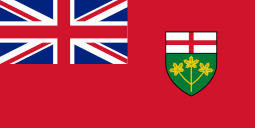Kenora—Rainy River (provincial electoral district)
Kenora—Rainy River Ontario electoral district Ontario electoral district |
|---|
|
Kenora—Rainy River in relation to other electoral districts |
| Provincial electoral district |
|---|
| Legislature |
Legislative Assembly of Ontario |
|---|
| MPP |
Sarah Campbell
New Democratic |
|---|
| District created |
1999 |
|---|
| First contested |
1999 |
|---|
| Last contested |
2014 |
|---|
| Demographics |
|---|
| Population (2001) |
78,758 |
|---|
| Electors (2007) |
44,755 |
|---|
| Area (km²) |
336,783 |
|---|
| Pop. density (per km²) |
0.23 |
|---|
| Census divisions |
Kenora, Rainy River, Thunder Bay District |
|---|
| Census subdivisions |
Chapple, Dryden, Emo, Fort Frances, Kenora, Rainy River, Sioux Lookout |
|---|
Kenora—Rainy River is a provincial electoral district (riding) in northwestern Ontario, Canada, that has been represented in the Legislative Assembly of Ontario since 1999. It was created from Kenora, most of Rainy River and part of Lake Nipigon. The boundaries of the new district corresponded with the Kenora—Rainy River federal riding, until it was abolished in 2003. The provincial riding will continue to exist.
The riding is represented by Sarah Campbell for the NDP and was previously represented by Howard Hampton, former leader of the Ontario New Democratic Party. The riding includes the western three quarters of Kenora District, the western three quarters of the Rainy River District and the northwest corner of the Thunder Bay District.
History
In 1996, Ontario was divided into the same electoral districts as those used for federal electoral purposes. They were redistributed whenever a readjustment took place at the federal level.
In 2005, legislation was passed by the Legislature to divide Ontario into 107 electoral districts, beginning with the next provincial election in 2007. The eleven northern electoral districts, including Kenora—Rainy River, are those defined for federal purposes in 1996, based on the 1991 census (except for a minor boundary adjustment). The 96 southern electoral districts are those defined for federal electoral purposes in 2003, based on the 2001 census. Without this legislation, the number of electoral districts in northern Ontario would have been reduced from eleven to ten.[1]
Members
Election results
^ Change is from redistributed results
2007 electoral reform referendum
Notes
- ↑ Elections Ontario web site, “New Electoral Boundaries”
- ↑ Elections Ontario (2014). "General Election Results by District 035, Kenora-Rainy River". Retrieved 13 June 2014.
- ↑ Elections Ontario (2011). "Official return from the records / Rapport des registres officiels - Kenora—Rainy River" (PDF). Retrieved 1 June 2014.
Sources
|
|---|
|
| Northern | |
|---|
|
| Eastern | |
|---|
|
| Central | |
|---|
|
| Midwestern | |
|---|
|
| Southwestern | |
|---|
|
Brampton, Mississauga
& Oakville | |
|---|
|
Hamilton, Burlington
& Niagara | |
|---|
|
| Ottawa | |
|---|
|
| South Durham, York | |
|---|
|
| Toronto | |
|---|
|
|
Coordinates: 51°N 92°W / 51°N 92°W / 51; -92